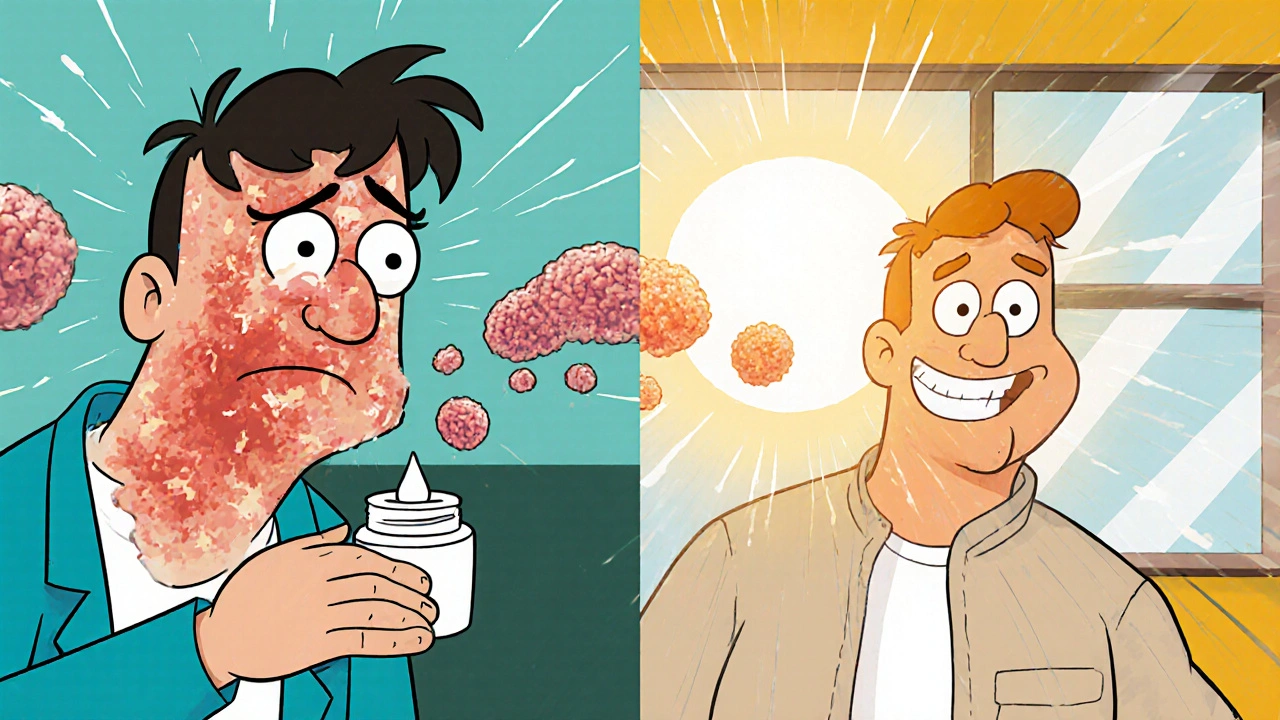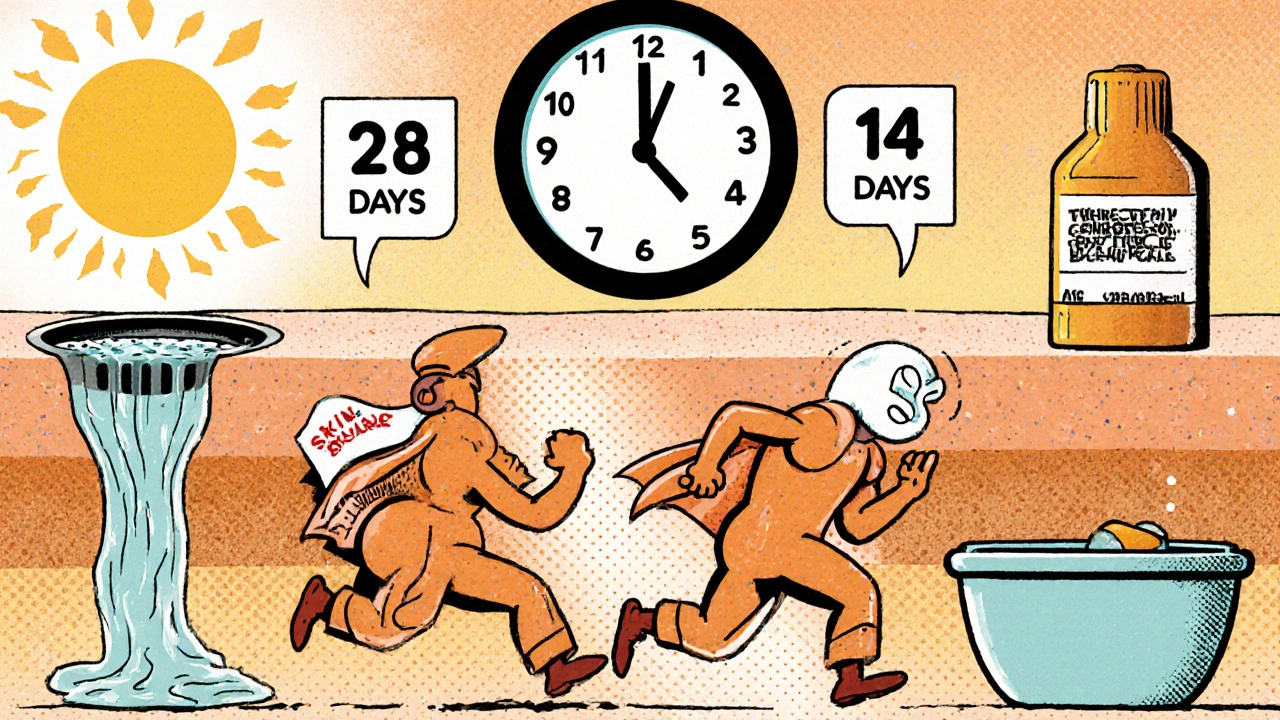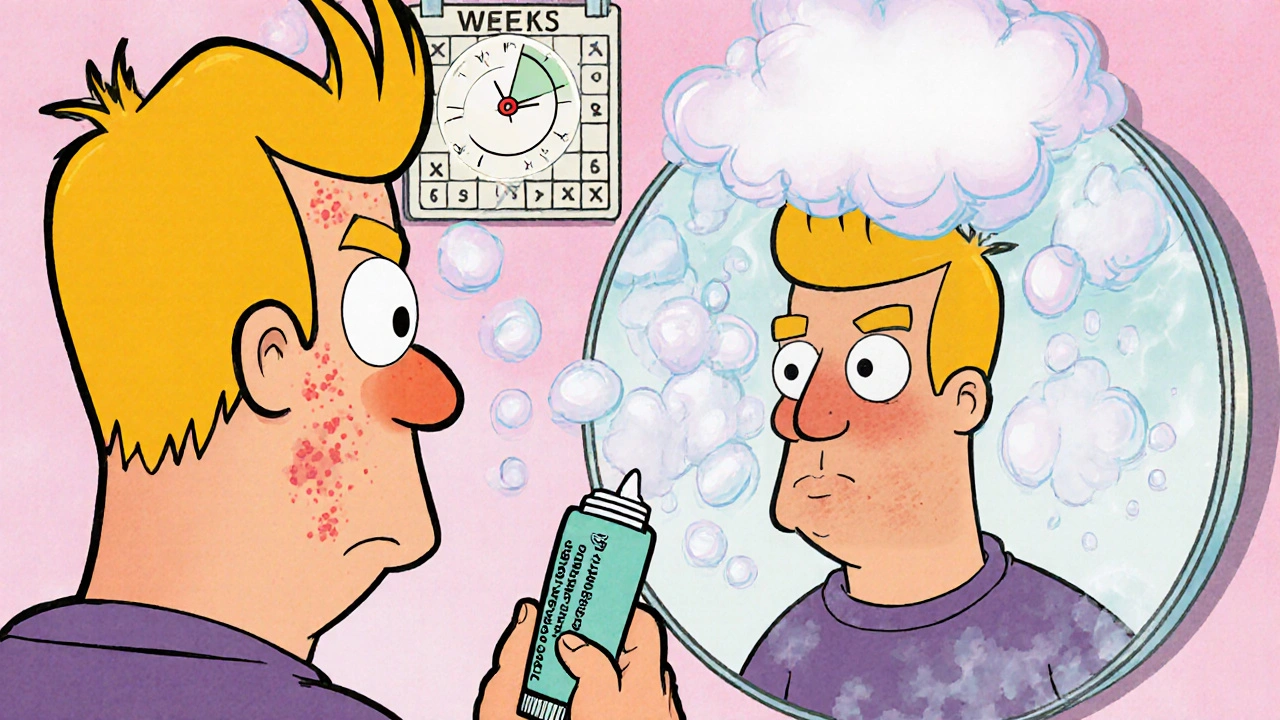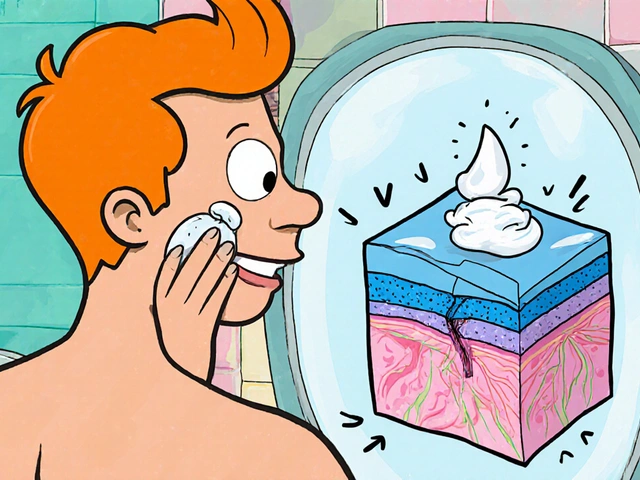When you start using tazarotene, you’re not looking for instant magic-you’re looking for real change. But how long does it actually take before you notice your skin getting better? If you’ve been told it could take weeks, or even months, you’re not alone. Many people stop using it too soon because they don’t see results fast enough. The truth? Tazarotene works, but it plays the long game.
What Is Tazarotene?
Tazarotene is a topical retinoid, a type of medication derived from vitamin A. It’s not your average over-the-counter cream. It’s prescription-strength and used for two main skin conditions: acne and plaque psoriasis. Unlike moisturizers or gentle exfoliants, tazarotene works at the cellular level. It speeds up skin cell turnover, unclogs pores, and reduces inflammation. For acne, that means fewer blackheads and pimples. For psoriasis, it flattens thick, scaly patches and calms redness.
It’s sold under brand names like Tazorac and Avage, but generic versions are just as effective. You apply it once daily, usually at night, to clean, dry skin. It’s not a quick fix. If you expect your skin to clear up in three days, you’ll be disappointed-and possibly irritated.
Acne: When Do You Start Seeing Results?
If you’re using tazarotene for acne, most people begin to notice improvements between 4 and 8 weeks. That’s about one to two months. But don’t confuse early improvement with full results. Your skin might look worse before it gets better. That’s normal. You could see more breakouts at first-this is called purging. It happens because tazarotene pushes out clogged pores that were already forming under the surface.
By week 12, you should see a clear reduction in inflammatory lesions-those red, swollen pimples. Studies show that after 12 weeks of daily use, people using tazarotene saw up to a 60% reduction in acne lesions compared to placebo. After 24 weeks, that number climbs to 70% or more. That’s not just a little better. That’s life-changing for many.
One patient in Birmingham, who started tazarotene in January, told me she felt like she was failing after six weeks. Her skin was dry and flaky, and she had new bumps. She almost quit. But she stuck with it. By week 16, her cheeks were clear. By week 20, she stopped hiding behind makeup. That’s the pattern: slow, then sudden.
Psoriasis: A Longer Road
For psoriasis, the timeline is longer. People using tazarotene for plaque psoriasis usually need 12 weeks to see noticeable improvement. Some need up to 24 weeks. That’s six months. It’s not unusual to still have some scaling or redness at 12 weeks-especially if your plaques are thick or longstanding.
The FDA-approved studies show that after 12 weeks, about half of users saw at least a 50% improvement in their psoriasis severity. After 24 weeks, nearly 70% saw a 75% improvement. That’s not just fading-it’s near-clearing for many.
One key thing: tazarotene works best when used with a moisturizer. Psoriasis skin is dry and fragile. Skipping moisturizer doesn’t make tazarotene stronger-it just makes your skin more irritated. Use a fragrance-free cream right after washing, even if you’re not applying tazarotene that day.
Why Does It Take So Long?
Tazarotene doesn’t just sit on the surface. It penetrates deep into the skin layers, changing how cells grow and die. Skin cells normally take about 28 days to move from the bottom layer to the top and shed. Tazarotene cuts that cycle in half. But even then, you need multiple cycles to clear out years of buildup-whether that’s clogged pores or thick psoriatic plaques.
Think of it like cleaning a clogged drain. You don’t turn on the water and expect it to clear instantly. You need time for the pressure to push out the gunk. Tazarotene is that pressure. It’s constant. It’s slow. But it’s effective.

What If You Don’t See Results After 12 Weeks?
If you’ve used tazarotene every day for 12 weeks and still see no improvement, talk to your doctor. It could mean one of three things:
- You’re not applying it correctly-too much, too often, or on damp skin.
- Your skin is too sensitive-you need to reduce frequency to every other day.
- You need a different treatment-maybe combined with benzoyl peroxide, antibiotics, or light therapy.
Don’t double up the dose. More doesn’t mean faster. It just means more redness, peeling, and burning. That’s not progress-it’s damage.
Side Effects: What to Expect
Side effects are common, especially in the first month. Dryness, peeling, stinging, and redness are normal. They usually fade after 4 to 6 weeks as your skin adjusts. If your skin feels raw, burns constantly, or you get blisters, stop using it and call your doctor.
One thing no one tells you: tazarotene makes your skin more sensitive to the sun. Even on cloudy days in Birmingham, UV rays can still damage your skin. Always use a broad-spectrum SPF 30+ every morning. Skip sunscreen, and you risk burns, dark spots, or worse.
How to Maximize Your Results
Here’s what actually works:
- Apply a pea-sized amount to the entire affected area-not just individual spots.
- Use it at night. Sunlight breaks it down and makes your skin more sensitive.
- Wait 20 minutes after washing your face before applying.
- Use a gentle, non-foaming cleanser. Avoid scrubs or alcohol-based toners.
- Moisturize daily, even if you’re not using tazarotene that day.
- Be patient. Don’t switch products every few weeks.
One mistake I see over and over: people use tazarotene with other strong actives like salicylic acid, glycolic acid, or retinol. That’s a recipe for irritation. Stick to one retinoid at a time. Let your skin heal.

Realistic Expectations
Tazarotene isn’t a miracle cure. It won’t erase scars or fix deep wrinkles. But for acne and psoriasis? It’s one of the most effective topical treatments you can use. The key is consistency. You don’t need perfect skin to see results-you just need to keep using it.
Most people who stick with it for six months see dramatic improvement. Those who quit early? They go back to where they started. And then they wonder why nothing works.
When to Call Your Doctor
Stop tazarotene and call your doctor if you experience:
- Severe burning, blistering, or swelling
- Worsening of acne or psoriasis after 4 weeks
- Signs of infection-pus, warmth, or fever
- Extreme dryness that won’t improve with moisturizer
Also, if you’re pregnant or planning to be, don’t use tazarotene. It’s a Category X drug-meaning it can cause serious birth defects. Always tell your doctor if you’re trying to conceive.
How long does it take for tazarotene to work on acne?
Most people start seeing improvements in acne between 4 and 8 weeks. Significant results-like fewer inflamed pimples and clearer skin-usually appear by week 12. Full results often take 24 weeks of daily use. Don’t stop if your skin looks worse at first-that’s purging, not failure.
Does tazarotene work faster for psoriasis than acne?
No, it usually takes longer for psoriasis. While acne shows improvement in 4-8 weeks, psoriasis often needs 12 weeks to start responding, and full results can take up to 24 weeks. Thicker plaques require more time to soften and flatten.
Why does my skin get worse before it gets better with tazarotene?
Tazarotene speeds up skin cell turnover, pushing out clogged pores and trapped debris. This causes what’s called purging-temporary breakouts or flares. It’s not an allergic reaction. It’s your skin clearing out old buildup. This usually lasts 2-6 weeks. If it lasts longer or gets severe, talk to your doctor.
Can I use tazarotene every day?
Yes, but only if your skin tolerates it. Many people start with every other night to reduce irritation. Once your skin adjusts (usually after 4-6 weeks), daily use is safe and more effective. Never apply it to wet skin or over broken skin.
What happens if I stop using tazarotene?
Your skin will eventually return to its previous state. Acne and psoriasis are chronic conditions. Tazarotene manages them-it doesn’t cure them. Stopping means symptoms will likely return within weeks to months. For lasting results, you need to keep using it, even after your skin clears.
Can I use moisturizer with tazarotene?
Yes, and you should. Moisturizing helps reduce dryness and irritation without reducing tazarotene’s effectiveness. Apply moisturizer 20 minutes after tazarotene, or use it on days you skip application. Look for fragrance-free, non-comedogenic formulas.
Is tazarotene safe for long-term use?
Yes, when used as directed. Studies show tazarotene is safe for long-term use in both acne and psoriasis. Many patients use it for years with no serious side effects. Regular skin checks and sunscreen use are essential to prevent sun damage.
Final Thoughts
Tazarotene isn’t for everyone. It’s strong, it’s irritating, and it demands patience. But for those who stick with it, the results are real. Clearer skin. Fewer flare-ups. Less reliance on other treatments. If you’re willing to give it six months, it might just change your relationship with your skin-for good.




